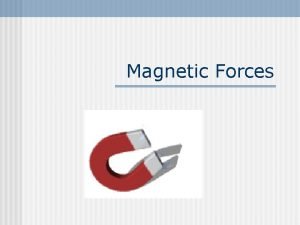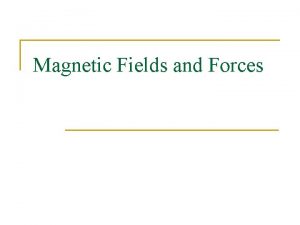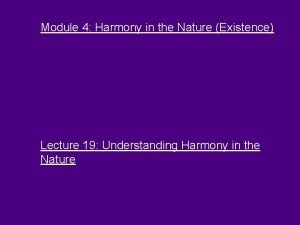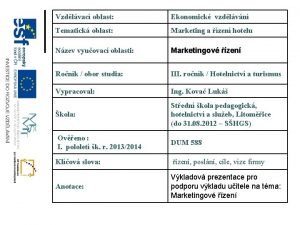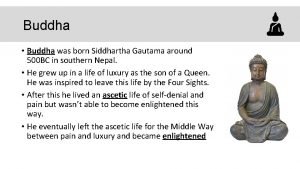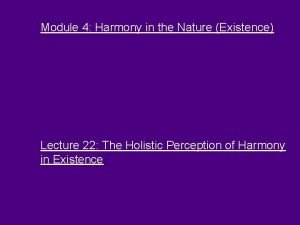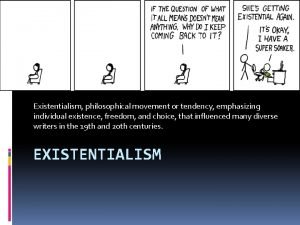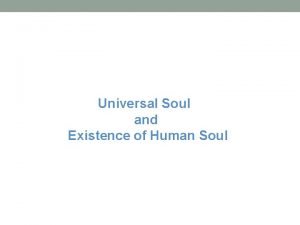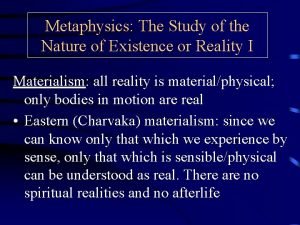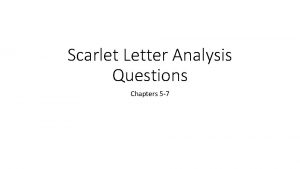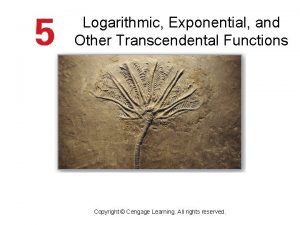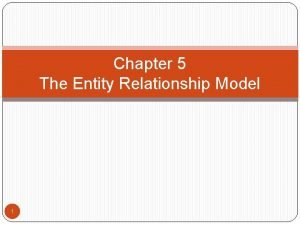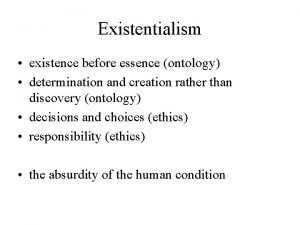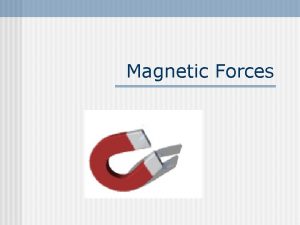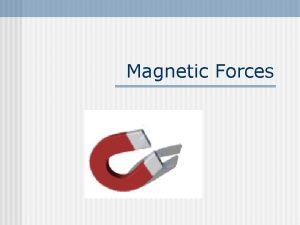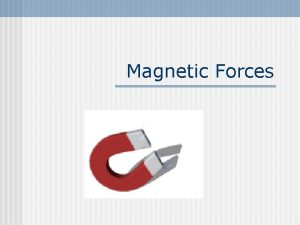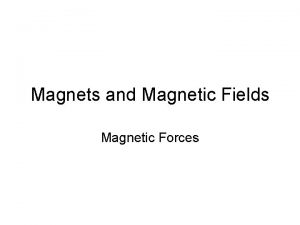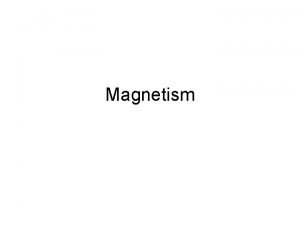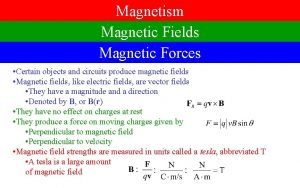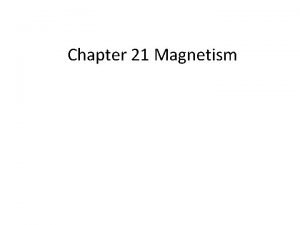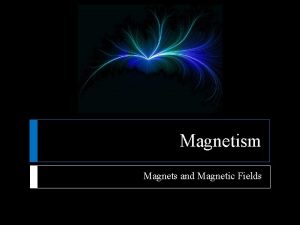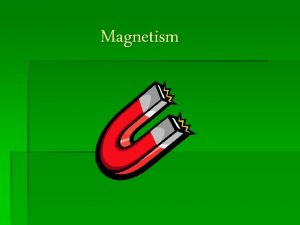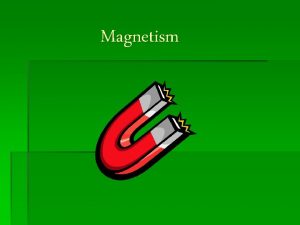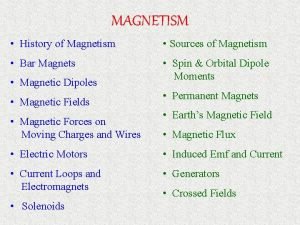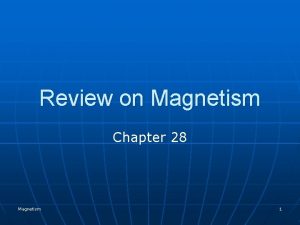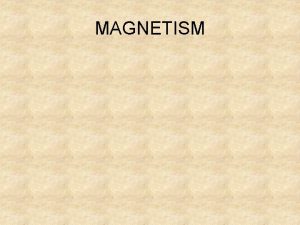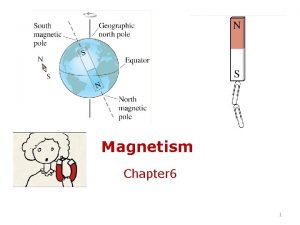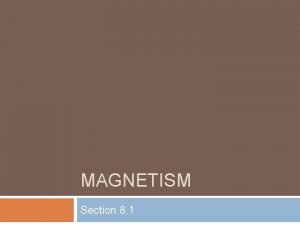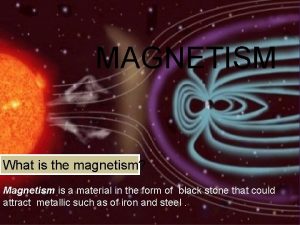Magnetic Forces Forces in Magnetism n The existence

























- Slides: 25

Magnetic Forces

Forces in Magnetism n The existence of magnetic fields is known because of their affects on moving charges. n n n What is magnetic force (FB)? How does it differ from electric force (FE)? What is known about the forces acting on charged bodies in motion through a magnetic field? • Magnitude of the force is proportional to the component of the charge’s velocity that is perpendicular to the magnetic field. • Direction of the force is perpendicular to the component of the charge’s velocity perpendicular to the magnetic field(B).

Magnetic Force (Lorentz Force) FB = |q|v. B sinθ n n Because the magnetic force is always perpendicular to the component of the charge’s velocity perpendicular to the magnetic field, it cannot change its speed. Force is maximum when the charge is moving perpendicular to the magnetic field ( = 90 ). The force is zero if the charge’s velocity is in the same direction as the magnetic field ( = 0 ). Also, if the speed is not changing, KE will be constant as well.

What is the magnetic field (B)? n The magnetic field is a force field just like electric and gravitational fields. n n n It is a vector quantity. Hence, it has both magnitude and direction. Magnetic fields are similar to electric fields in that the field intensity is directly proportional to the force and inversely related to the charge. E = FE/q B = FB/(|q|v) Units for B: N • s/C • m = 1 Tesla

Right Hand Rules n Right hand rule is used to determine the relationship between the magnetic field, the velocity of a positively charged particle and the resulting force it experiences.

Right Hand Rules #1 #2 FB = |q|v x B #3

The Lorentz Force Equation & RHR FB = qv. B sinθ v sinθ + V θ Uniform B q What is the direction of force on the particle by the magnetic field? a. Right b. Left c. Up d. Down e. Into the page f. Out of the Page

Right Hand Rule – What is the Force? x x x x v x + x x x Start Monday 4/11 x x x What is the direction of the magnetic force on the charge? a) Down b) Up c) Right d)Left

Right Hand Rule – What is the Charge? Particle 1: a. Positive b. Negative c. Neutral Particle 2: a. Positive b. Negative c. Neutral Particle 3: a. Positive b. Negative c. Neutral

Right Hand Rule – What is the Direction of B What is the direction of the magnetic field in each chamber? a. b. c. d. e. f. Up Down Left Right Into Page Out of Page 1 4 2 3 What is the speed of the particle when it leaves chamber 4? a. v/2 b. -v c. v d. 2 v Since the magnetic force is always perpendicular to the velocity, it cannot do any work and change its KE.

Example 2: Lorentz Force Two protons are launched into a magnetic field with the same speed as shown. What is the difference in magnitude of the magnetic force on each particle? a. F 1 < F 2 b. F 1 = F 2 c. F 1 > F 2 F = qv x B = qv. Bsinθ Since the angle between B and the particles is 90 o in both cases, F 1 = F 2. + x x x v 1 v 2 How does the kinetic energy change once the particle is in the B field? a. Increase b. Decrease c. Stays the Same Since the magnetic force is always perpendicular to the velocity, it cannot do any work and change its KE.

Trajectory of a Charge in a Constant Magnetic Field n What path will a charge take when it enters a constant magnetic field with a velocity v as shown below? + v x x x x x x § Since the force is always perpendicular to the v and B, the particle will travel in a circle § Hence, the force is a centripetal force.

Crossed Fields + - B into page n n n v - + + x Fx. E x -x x Fx. B - v E - + + x x x - - v - E and B fields are balanced to control the trajectory of the charged particle. FB = F E Velocity Selector qv. B = q. E v = E/B Phosphor Coated Screen

Earth’s Magnetosphere n Magnetic field of Earth’s atmosphere protects us from charged particles streaming from Sun (solar wind)

Aurora n Charged particles can enter atmosphere at magnetic poles, causing an aurora

Force on a Current Carrying Wire FB = |q|v x B = qv. B sinθ (1) Lets assume that the charge q travels through the wire in time t. FB = ( q)v. Bsinθ When t is factored in, we obtain: FB = ( q/ t)(v t) Bsinθ Where: q/ t = I (current) v t = L (length of wire) Equation (2) therefore reduces to: FB = BIL sinθ (2)

External Magnetic Field – Electromagnet or permanent magnet that provides an attractive and repulsive force to drive armature. DC Motor Split Ring Commutator – Brushes and split ring that provide the electrical connection to the armature from the external electrical source. DC Electric Motor Armature – Part of the motor that spins that contains windings and an iron core.

Key Ideas n n n Lorentz Force: A charge moving perpendicular to a magnetic field will experience a force. Charged particles moving perpendicular to a magnetic field will travel in a circular orbit. The magnetic force does not change the kinetic energy of a moving charged particle – only direction. The magnetic field (B) is a vector quantity with the unit of Tesla Use right hand rules to determine the relationship between the magnetic field, the velocity of a positively charged particle and the resulting force it experiences.

Radius of Circular Orbit Lorentz Force: F = qv x B Centripetal Acc: ac = v 2/R Newton’s Second Law: F = mac qv. B = mv 2/R R = mv/q. B x x x x x x R Fc v + What is the radius of the circular orbit?

Crossed Fields in the CRT n How do we make a charged particle go straight if the magnetic field is going to make it go in circles? n n Use a velocity selector that incorporates the use of electric and magnetic fields. Applications for a velocity selector: n Cathode ray tubes (TV, Computer monitor)

Torque on a Current Carrying Coil (Electric Motors/Galv. ) = F • r

Torque on a Current Carrying Coil (cont. ) F F F • w -F Zero Torque B x • x -F I x • Direction of Rotation -F Max Torque Axis of Rotation

Torque on a Current Carrying Coil (cont. ) n n At zero torque, the magnetic field of the loop of current carrying wire is aligned with that of the magnet. At maximum torque, the magnetic field of the loop of current carrying wire is at 90 o. The net force on the loop is the vector sum of all of the forces acting on all of the sides. When a loop with current is placed in a magnetic field, the loop will rotate such that its normal becomes aligned with the externally applied magnetic field.

Torque on a Current Carrying Coil (cont. ) n What is the contribution of forces from the two shorter sides (w)? F = Iw. B sin (90 o – ) Note 1: is the angle that the normal to the wire makes with the direction of the magnetic field. Note 2: Due to symmetry, the forces on the two shorter sides will cancel each other out (Use RHR #1). L w Axis of rotation X X X X I

Torque on a Current Carrying Coil (cont. ) n What is the contribution of torque from the two longer sides (L)? F = BIL for each side since L is always perpendicular to B. The magnitude of the torque due to these forces is: = BIL (½w sin ) + BIL (½w sin ) = BILw sin (1) Note: Since Lw = the area of the loop (A), (1) reduces to: = IAB sin For a winding with N turns, this formula can be rewritten: = NIAB sin
 Conceptual physics magnetism
Conceptual physics magnetism Right hand rule 1
Right hand rule 1 F=i(lxb)
F=i(lxb) Coercivity
Coercivity Weber magnetism
Weber magnetism Magnetic moment and magnetic field relation
Magnetic moment and magnetic field relation Learning: module 26: magnetic forces and fields
Learning: module 26: magnetic forces and fields Trivia about magnetism
Trivia about magnetism Harmony in the nature and existence
Harmony in the nature and existence Three marks of existence
Three marks of existence účel (smysl) existence firmy určuje
účel (smysl) existence firmy určuje 3 marks of existence
3 marks of existence Existence
Existence Explain the holistic perception of harmony in existence
Explain the holistic perception of harmony in existence Existence and uniqueness of square roots and cube roots
Existence and uniqueness of square roots and cube roots Existentialism movement
Existentialism movement Moral argument for god's existence
Moral argument for god's existence Three marks of existence
Three marks of existence Universal soul theory
Universal soul theory Arctic fox niche
Arctic fox niche Study of the nature of existence
Study of the nature of existence Scarlet letter chapter 5-7 summary
Scarlet letter chapter 5-7 summary Logarithmic exponential and other transcendental functions
Logarithmic exponential and other transcendental functions The function that an entity plays in a relationship
The function that an entity plays in a relationship Existence before essence
Existence before essence The three characteristics of existence
The three characteristics of existence

